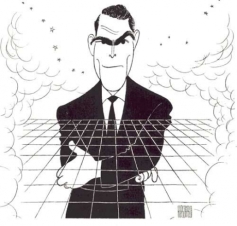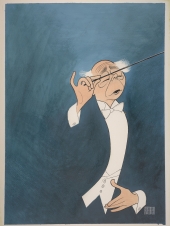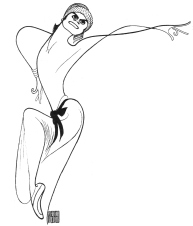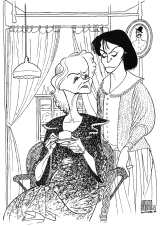What Happened in 1983
For a series of collector plates, Hirschfeld creates eight images of dance postures in a circular format.
For the Smithsonian, Hirschfeld creates two iconic portraits of American Popular Song. The first of great singers; the second of great songwriters.
Draws his signature self portrait at the barber chair as part of a private commission.
His drawing of Jason Robards, Colleen Dewhurst, James Coco, and Elizabeth Wilson in a revival of You Can't Take It With You is published as a limited edition etching.
Draws a portrait of the five alternating leads in Peter Brooks’s version of Carmen.
His portrait of Charles Ludlam in Galas appears in the Times Friday theatre column.
Decade: 1980
…For half a century now, Al Hirschfeld has been turning out these uncanny wonders, joyous masterpieces of theatrical caricature, in a drab attic studio, his stubby body perched in an old barber chair he bought 35 years ago in the Bowery, arching over a drawing board cross-hatched with a zillion Exacto grooves.
It’s been a hectic time for Hirschfeld –five shows open soon, plus the new TV season, which means a dozen deadlines in ten days for the The New York Times and TV Guide, his main outlets.
He just back from Baltimore, where he saw a preview of Jean Kerr’s new play and, a sketch pad in his lap, feverishly drew a rough draft of the stars, working in the spillover light from the stage. He rips a page off a thick pad on which he’s scribbled primitive versions of Gilda Radner and Sam Waterson in pencil.
…His ambition, still, is to reveal the most personality in the fewest strokes. “The anatomy isn’t interesting to me. I try to stay away from eye-ear-nose-and-throat likenesses. A big nose, you make it bigger –but that’s witless. What I try for is how he seems.”
…’I’m still involved with the mystery of line and what it can do. I’ve found no formulas; it’s difficult not fall back on what you did before. All I know is to keep paring it down, eliminating, until it’s pure line that communicates.








